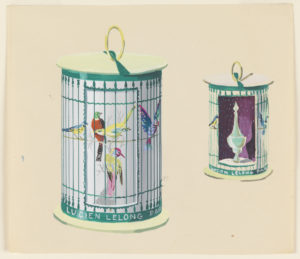In celebration of our new exhibition The Senses: Design Beyond Vision, this Object of the Day post explores the multisensory experience of an object in Cooper Hewitt’s permanent collection.
The name of Lucien Lelong unquestionably conjures up the luxurious world of French fashion. Born in Paris as the son of a textile shop owner, Lelong attended the Hautes Études Commerciales at the age of 22. Upon graduating, his first designs were featured in Vogue, and he released a complete collection a year later.[1] Though Lelong exhibited an extraordinary talent for understanding the relationship between fashion and the body, his priorities were as a businessman with a hope to “industrialize haute couture” in France.[2] In the couture shop that Lelong opened in 1919, he acted as an overseer, and his shop eventually became the fundamental training ground for upcoming top fashion icons such as Hubert de Givenchy, Jean Ebel, Pierre Balmain, and Christian Dior.[3]
When fashion designers began to dabble in scent production in the early 1900s, smelling pleasant was already intricately linked with looking fashionable. People “‘dress[ed] not only for the eyes, but for the other senses as well.'”[4] In 1924, Lelong started his experiments in the field of fragrance, which he considered “an integral part of a woman’s style.”[5] This perfume package prototype in Cooper Hewitt’s collection was designed to present one of LeLong’s pioneering fragrances. The predominant hue of the box’s design, known as one variation of Lelong’s feature color “new leaf green,” contrasts strongly with the light gray background.[6] The central window of the birdcage highlights a peacock-like bird with colorful feathers, and additional exotic birds surround the rest of the package.

Drawing, Design for Perfume Bottle with Bird-Cage Packaging, 1940-59; Designed by Lucien Lelong (French, 1926-1953); Brush and gouache on cream paper; 21 x 23.8 cm (8 1/4 x 9 3/8 in.); Gift of Monique Fink, 1990-149-5
A drawing in Cooper Hewitt’s collection provides further insights about the functionality and presentation of Lelong’s elaborate perfume packaging. The user’s interaction with the elaborate box further highlights that sense of mystery—sliding the central window of the birdcage would reveal an elaborate bottle shining within a dark purple interior studded with stars. By wearing such preciously packaged perfume, Lelong’s female customers compare their beauty to delicate exotic birds with an enigmatic allure.[7]
The Senses: Design Beyond Vision is on view at Cooper Hewitt through October 28, 2018.
Binglei Yan is a curatorial capstone fellow for The Senses: Design Beyond Vision. She is an MA candidate in the History of Design and Curatorial Studies program offered at Parsons The New School of Design jointly with Cooper Hewitt, Smithsonian Design Museum.
[1] “History,” Parfums Lucien Lelong , accessed February 6, 2018, http://lucienlelong.com/index.php?main_page=page&id=4&zenid=9d961c146222372494fb63ea36f7b1ba.
[2] “Lucien Lelong: The Man Who Saved Paris,” Telegraph, November 21, 2008, accessed February 6, 2018, http://fashion.telegraph.co.uk/news-features/TMG3497094/Lucien-Lelong-the-man-who-saved-Paris.html.
[3] “History.”
[4] Marian Mcevoy, “Beauty; The Fashion for Fragrance,” The New York Times Magazine, May 18, 1986, accessed April 6, 2018, https://www.nytimes.com/1986/05/18/magazine/beauty-the-fashion-for-fragrance.html.
[5] Sara Idacavage, “Fashion History Lesson: The Truth Behind Chanel No.5,” Fashionista, November 15, 2016, accessed March 2, 2018, https://fashionista.com/2016/11/chanel-perfume-no-5-history.
“History.”
[6] “Lucien Lelong~ 1889-1958,” Head to Toe Fashion Art, last modified June 29, 2014, accessed February 9, 2018, http://headtotoefashionart.com/lucien-lelong-1889-1958/.
[7] “History.”
